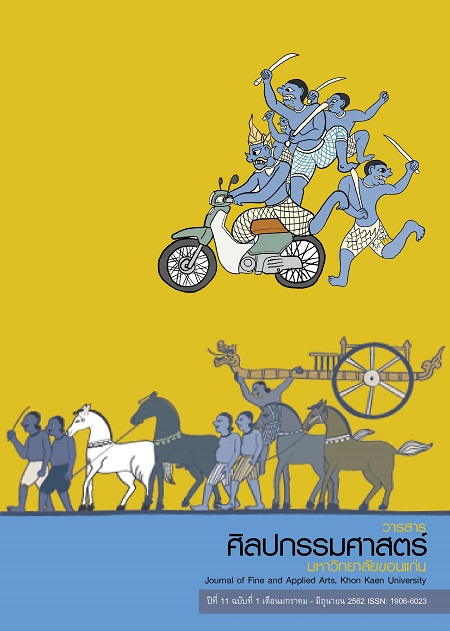Knowledge Management in Performing Local Arts of lumRueng Tor Glorn in RattanasinIntathairat Group
Main Article Content
Abstract
The objective of this study was to study of knowledge management in performing local arts of “lumRueng Tor Glorn” (The Thai Northeast Musical) in RattanasinIntathairat group. The qualitative research method was used.The instruments used in the study were interview form and questionnaire. The data were analyzed by translating and interpreting the poem, the triangulation test and descriptive analysis. Then the researcher found that the purpose of RattanasinIntathairat singer group is still keeps on singing MawlumGlorn, easpecially singing in local style. Nowadays, whatever people asks for showing LukThung dance songs during showing LumRueng.
Knowledge management in RattanasinIntathairat group found that performing LumRueng Tor Glorn has developed the order of performance and scene. It becomes the style that being used today. Moreover, this group brought music technology, scene, ornament and clothes to adapt to perform LumRueng Tor Glorn until it becomes tacit knowledge and then into explicit knowledge by writing all the knowledge on their notebook. The most performers have experienced in performing arts for many years so that they got tacit knowledge, they showed it through act along story expertly. A difficult problem of knowledge management is someone that has more experiencein Mawlum group quit his job. It is hard to recruit a new performer that has more experience or talent instead of an old one. Finally, the leader found the way to manage a new performer by adapting the story accord to him.
This article would be good for the interested people, lecturer or teachers who want to establish or study their own LumRueng Tor Glorn. The people can bring the order of performing and scene to product their own Mawlum for their school performance.
Article Details
Content and information in articles published in the Journal of Fine and Applied Arts of Khon Kaen University is regarded as the opinion and sole responsibility of the author(s) directly; therefore, editors are not obliged to agree to or share any responsibility with regard to the content and information that appears within these articles.
All articles, information, content, image, etc. that have been published in the Journal of Fine and Applied Arts of Khon Kaen University is the copyright of the Journal of Fine and Appllied Arts of Khon Kaen University. Any person or organization who wishes to distribute all or parts of the articles for further dissemination or other usage must first receive permission from the Journal of Fine and Applied Arts of Khon Kaen University before proceeding to do so.
References
จิราวัลย์ ซาเหลา. (2546). กระบวนการเรียนรู้และการถ่ายทอดศิลปะการแสดงของหมอลำอาชีพ. วิทยานิพนธ์ปริญญาศึกษามหาบัณฑิต สาขาวิชาการศึกษานอกระบบ บัณฑิตวิทยาลัย จุฬาลงกรณ์มหาวิทยาลัย.
บรรพต วีระสัย และผจงจิตต์ อธิคมนันทะ. (2543). การเปลี่ยนแปลงทางสังคมและวัฒนธรรม. ใน คณาจารย์ภาควิชาสังคมวิทยาและมานุษยวิทยา (บรรณาธิการ). สังคมวิทยาและมานุษยวิทยาเบื้องต้น. (หน้า 315). พิมพ์ครั้งที่ 17.กรุงเทพฯ: มหาวิทยาลัยรามคำแหง.
ประเวศ วะสี. (2548). การจัดการความรู้ : กระบวนการปลดปล่อยมนุษย์ส่ศักยภาพ เสรีภาพและความสุข. กรุงเทพฯ: สถาบันส่งเสริมการจัดการความรู้เพื่อสังคม.
เยาวภา ดำเนตร. (2536). วิถีชีวิตของชาวอีสานจากกลอนลำทางยาวของลำกลอน. ปริญญานิพนธ์ศิลปศาสตร มหาบัณฑิต สาขาวิชาเอกไทยคดีศึกษา (เน้นสังคมศาสตร์) บัณฑิตวิทยาลัย มหาวิทยาลัยศรีนครินทรวิโรฒ.
ลักษณวัต ปาละรัตน์. (2553). ญาณวิทยา (ทฤษฏีความรู้). พิมพ์ครั้งที่ 2. กรุงเทพฯ: มหาวิทยาลัยราคำแหง.
สนอง คลังพระศรี. (2541). หมอลำซิ่ง : กระบวนการปรับเปลี่ยนทางวัฒนธรรมดนตรีของหมอลำในภาคอีสาน.วิทยานิพนธ์ปริญญาศิลปศาสตรมหาบัณฑิต สาขาวิชาวัฒนธรรมศึกษา บัณฑิตวิทยาลัย มหาวิทยาลัยมหิดล.
อภิสิทธิ์ เบื้องบน. (2555). การพัฒนาหมอลำกลอนในกระแสโลกาภิวัฒน์. วิทยานิพนธ์ปริญญาศิลปกรรมศาสตรมหาบัณฑิต สาขาวิชาดริยางคศิลป์ บัณฑิตวิทยาลัย มหาวิทยาลัยมหาสารคาม.


